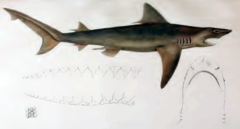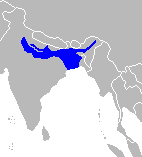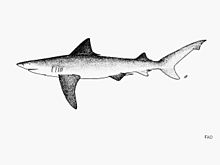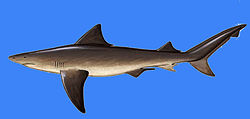
Ganges shark
Did you know...
SOS believes education gives a better chance in life to children in the developing world too. Do you want to know about sponsoring? See www.sponsorachild.org.uk
| Ganges shark | |
|---|---|
 |
|
| Conservation status | |
 Critically Endangered ( IUCN 3.1) |
|
| Scientific classification | |
| Kingdom: | Animalia |
| Phylum: | Chordata |
| Class: | Chondrichthyes |
| Subclass: | Elasmobranchii (sharks and rays) |
| Order: | Carcharhiniformes (ground sharks) |
| Family: | Carcharhinidae (requiem sharks) |
| Genus: | Glyphis |
| Species: | G. gangeticus |
| Binomial name | |
| Glyphis gangeticus ( J. P. Müller & Henle, 1839) |
|
 |
|
| Glyphis gangeticus inhabits the Ganges-Hooghly River system | |
| Synonyms | |
|
|
The Ganges shark (Glyphis gangeticus) is a critically endangered species of requiem shark found in the Ganges River of India. It is often confused with the more common bull shark (Carcharhinus leucas), which also inhabits the Ganges River and is sometimes incorrectly referred to as the Ganges shark. Unlike bull sharks, which need to migrate to salt water to reproduce, species in the genus Glyphis are true river sharks. The genus contains a total of six known species, only half of which are described.
Physical appearance
G. gangeticus is a little-known species that is yet to be adequately described. Its size at birth is 56 to 61 cm, growing to an estimated 178 cm at maturity, with a maximum size of about 204 cm. It is worth noting that the size at birth or maturity is unknown for any other Glyphis species.
A typical requiem shark in its external appearance, it is stocky, with two spineless dorsal fins and an anal fin. The first dorsal fin originates over the last third of the pectoral fins, with a free rear tip that is well in front of the pelvic fins. The second dorsal fin is relatively large, but much smaller than the first (about half the height). The anal fin is slightly smaller than the second dorsal fin and the pectoral fins are broad. There is a longitudinal upper precaudal pit, but no interdorsal ridge. It is uniformly gray to brownish in colour, with no discernible markings.
Its snout is broadly rounded and much shorter than the width of its mouth. The mouth is long, broad, and extends back and up towards the eyes.
Its eyes are minute, suggesting that it may be adapted to turbid water with poor visibility, such as occurs in the Ganges River and the Bay of Bengal. It has internal nictitating eyelids.
The upper teeth have high, broad serrated triangular cusps and the labial furrows are very short. The lower front teeth have long, hooked, protruding cusps with unserrated cutting edges along the entire cusp, but without spearlike tips and with low cusplets on feet of crowns. The tooth row counts are 32–37/31–34.
Diagnostic features
G. gangeticus can be identified by the first few lower front teeth, which have cutting edges along entire cusp, giving the cusps a clawlike shape, and low cusplets. Also, a second dorsal fin that is about half the height of first dorsal is distinct to this species.
Distribution
The Ganges shark, as its name suggests, is largely restricted to the rivers of eastern and northeastern India, particularly the Hooghly River of West Bengal, and the Ganges, Brahmaputra, and Mahanadi in Bihar, Assam, and Odisha, respectively. It is typically found in the middle to lower reaches of a river.
In theory, G. gangeticus could occur in shallow marine estuaries; however there are no verified marine records of the species to date. Originally the species was assigned a wide range in the Indo-West Pacific, but this was found to be mostly based on other species of requiem sharks, particularly members of the genus Carcharhinus.
It should be noted that most literature records and specimens labelled as this species are in fact bull sharks (Carcharhinus leucas) or other Carcharhinid species. An extensive 10-year search produced only a few specimens, caught in 1996 in the Ganges River.
Habitat and ecology
G. gangeticus is known to inhabit only freshwater, inshore marine, and estuarine systems in the lower reaches of the Ganges-Hooghly River system. The feeding habits are mostly unknown. The shark’s small eyes and slender teeth suggest that it is primarily a fish-eater and is adapted to turbid water. With such limited visibility typical of many tropical rivers and estuaries, other senses − such as hearing, smell and electroreception − are likely used for predation. Because its eyes are tilted towards its back rather than to the sides or bottom (as is the case in most carcharhinids), it is thought that the shark may swim along the bottom and scan the water above it for potential prey back-lit by the sun. However, in the Bay of Bengal, G. gangeticus was found to feed heavily on dasyatid stingrays, which spend much of their time on the bottom.
Reproduction
It is probably viviparous, with a yolk-sac placenta (speculation through analogy to related species of carcharhinids). The litter size and gestation period are unknown. However, their life history cycle is probably similar to other river sharks, characterized by long gestation, slow growth, delayed maturity, and small litter size. These factors make the Ganges shark populations vulnerable to even relatively low levels of exploitation, such as sport angling or gill netting.
Possibility of migration
Some researchers consider G. gangeticus to be amphidromous, covering more than 100 km in both directions. However, this is not thought to be for breeding, as the case in anadromous and catadromous species. The presence of newborn individuals in the Hooghly River suggests that the young may be born in fresh water.
A specimen photographed in 2011 by natural history journalist Malaka Rodrigo at Negombo fish market in Sri Lanka prompted researcher Rex de Silva to speculate on whether the species could occasionally be carried south of its normal range by ocean currents. However, only the head of the shark appears in the photo. Leading shark expert Leonard Compagno emphasised the need to check the dentition and the dorsal fin proportions in order to confirm the specimen as G. gangeticus, stating that it could also be one of the four other named species.
Specimens
G. gangeticus was originally known only from three nineteenth century museum specimens: one each in the Muséum national d’Histoire Naturelle, Paris, Humboldt Museum, Berlin and Zoological Survey of India, Calcutta. No records exist between 1867 until 1996, and the 1996 records have not been confirmed as G. gangeticus. A specimen collected 84 km upstream of the mouth of the Hooghly River at Mahishadal in 2001 was identified as G. gangeticus but on photographs of the jaw only. If Carcharias murrayi (Günter, 1887) can be considered a junior synonym of this species, one was found near Karachi, Pakistan. However, the holotype was apparently lost or misplaced in the British Museum of Natural History.
Molecular biology
Glyphis species, like other sharks, exhibit a very slow rate of genetic change. This makes them even more vulnerable to becoming extinct, as they are unable to adapt to the rapid and extreme changes caused by humans to their environment.
As only a few specimens exist, naturally there is little material available for genetic sampling. However, two websites list records for G. gangeticus:
The Barcode of Life Data Systems (BOLDS) Stats website lists one record:
Public Records: 0
Specimens with Barcodes: 1
Species With Barcodes: 1
The NCBI Taxonomy database has one record of mitochondrial genetic material (1,044 base pairs of linear DNA):
Glyphis gangeticus bio-material GN2669, reported in a 2012 paper on DNA sequencing in shark and ray species.
Conservation
IUCN Red List Category: Critically Endangered (2007; Assessed by LJV Compagno)
Red List Criteria: A2cde; C2b ver 3.1
History: 1996: Critically Endangered (Baillie and Groombridge 1996)
G. gangeticus is one of 20 sharks on the International Union for Conservation of Nature and Natural Resources Red List of endangered shark species. Although only a few complete specimens have been collected, what is thought to be G. gangeticus jaws have appeared in international trade during recent years to testify that it is not extinct (L.J.V. Compagno pers. obs.). There is, however, no information to suggest that the population status of this species has improved. There is an urgent need for a detailed survey of the shark fisheries of the Bay of Bengal.
Major threats
River sharks are thought to be particularly vulnerable to habitat changes. The Ganges shark is restricted to a very narrow band of habitat that is heavily impacted by human activity. Overfishing, habitat degradation from pollution, increasing river use and management, including construction of dams and barrages are the principle threats. Thought to be consumed locally for its meat, the Ganges shark is caught by gillnet and its oil, along with that of the South Asian river dolphin, is highly sought after as a fish attractant. It is also believed to be part of the Asian shark fin trade.
Conservation actions
In 2001, the Indian government banned the landing of all species of chondrichthyan fish in its ports. However, shortly afterwards this ban was amended to cover only 10 species of chondrichthyans. These, including G. gangeticus are protected under Schedule I, Part II A of the Wildlife Protection Act of India. There is doubt about the effectiveness of this measure, however, because of difficulties in enforcement. There is a widespread, albeit widely dispersed, artisanal fishery for both local consumption and international trade. Compagno (1997) recommends an in-depth survey of fishing camps and landing sites, along with a sampling program in the Ganges system to determine the current status of this shark along with other gangetic elasmobranchs such as stingrays and sawfish.
Human interaction
The Ganges shark is widely feared as a ferocious man-eater. But most of the attacks attributed to it are probably the result of confusion with the bull shark Carcharhinus leucas. This is likely because bull sharks are known to travel long distances into freshwater systems and may co-exist in the same waters as the Ganges shark. But since little is known about the behaviour of genuine freshwater river sharks, and since G. gangeticus is critically endangered, contact with humans is probably very rare.
The biological differences between the Ganges shark and bull shark also point to a lower likelihood of attacks on humans by the Ganges shark. G. gangeticus has much narrower, higher, upper teeth and slender-cusped, less heavily built lower teeth than C. leucas. Such small sharp teeth are more suitable for fish-impaling and less useful for dismembering tough mammalian prey than the stout teeth of the bull shark.
Etymology and common names
Etymology
Glyphis: from Greek glyphe, meaning ‘carving’
Common names
Indian languages
Bengali: Hangar, Hungar, baagh maach (tiger fish)
Hindi: Magar sora
Kannada: Balliar, Bugga-karuvai-baliar, Buggakarvai, Tamasi
Malayalam: Valiya sravu
Marathi: Waghsheer
Oriya: Mundah magur
Tamil: Mundan sura, Murdan sorra
Telugu: Sorra
Other languages
Burmese: Nga-man-gaung-waing
English: Ganges shark, Gangetic shark
Dutch: Gangeshaai
French: Requin du Ganges
Spanish: Tibu´ron del Ganges
Vietnamese: Cá mập sông Giăng


